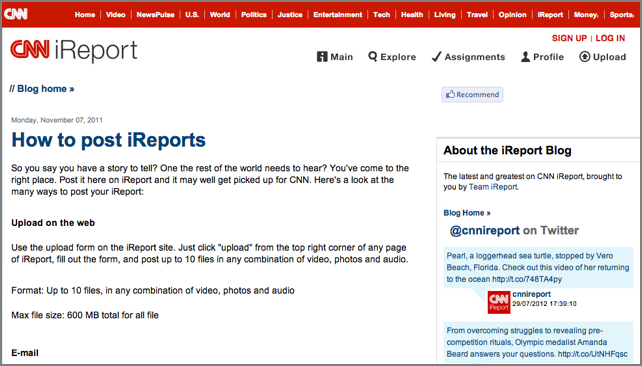
Citizen Journalism… And The Walls Came Tumbling Down
The world of the professional journalist, formally schooled and trained in delivering the ‘Who, What, Why, When, and Where’ of a news story, has been turned upside down and inside out. The legendary sign-off, “And that’s the way it is,” by renowned CBS News broadcast journalist Walter Cronkite, has lost the resonance it once had. Replacing it is an innumerable deluge of tweets, social sharing sites, blogs, and video news that relentlessly rains down on us 24/7. The advances in digital technology and the growth of the Internet have empowered a new era of ‘Citizen Journalism’ that has firmly planted a stake in the ground of today’s interconnected society.
BECOME A CITIZEN JOURNALIST AND CHANGE THE WORLD
Known by many names throughout the years, including guerrilla, public, grass roots, street or participatory, the concept of citizen journalism is simply that people who don’t have the journalistic academic background or correlating professional experience can and should be directly involved in journalism.
The Internet has proven to be the great equalizer of information dissemination. It enables people to instantly create and distribute information to and from people throughout the world, without the filters of what can and cannot be expressed. Using digital technologies and the Internet, citizen journalists can create, contradict or supplement news information for distribution simultaneously to local and worldwide audiences. Cell phones, with integrated still and video cameras, have been a great tool to help so many people to become citizen journalists in an instant.
The benefits of citizen journalism are two-fold. First, as a citizen, you have access to countless diverse perspectives, and even raw information happening in real-time on a global scale. Second, as a journalist, you can become a contributing member of that community by using technology as an outlet for your personal expression.
VIDEO NEWS BECOMING INTEGRAL PART OF CITIZEN JOURNALISM
There’s no question the Internet has been the enabling force of true citizen journalism today. Frankly, it can be hard to visit sites on the Internet without tripping over some flavor of it. The signature characteristic of citizen journalism has been side stepping the established channels and restrictions of professional news organizations. However, as we’ll see later, that is also changing.
The potential of citizen journalism took hold with the rapid expansion of the World Wide Web in the 1990’s. It allowed people to create a simple homepage and small websites where they could reach out to either a selected audience or the entire world to express their views. Today, many of those homepages have become blogs. Individuals shooting video of newsworthy events with a digital camera or the video recorder in a cell phone and then uploading the content to a blog to share with the world has become one of the more effective devices in a citizen journalist toolbox.
A big step up from blogging, and a more formal, better-financed alternative news source is The Huffington Post. Challenging the established media, it refers to itself as “The Internet Newspaper.” It, too, has a citizen journalist component where text, photographs, and video news can be submitted. This strategy has helped “Huff Post” flourish on the Internet. Advancing this commitment, they’ve partnered with UStream and created a video upload site that helps expand The Huffington Post’s capabilities for citizen journalists to deliver live, breaking news from mobile video devices.
For the less technically savvy, more causal, would-be citizen journalist, social networking websites like YouTube, Facebook and Twitter, offer easy ways to post videos online. These free services provide user-friendly platforms, with an extensive offering of tools and technology for various types of public and private communications using text, photos and video news content.
THE ESTABLISHMENT MEDIA ADDS VIDEO UPLOAD SITES
Typically, the institutional, card-carrying professional journalists tend to view ‘Citizen Journalists’ as interlopers; seen as amateurs without the skills, the fact-checking discipline nor an ethical code to temper the technical capability to publish whatever they choose. Luckily, not all in the business hold that view. In fact, one of the most prominent organizations, the Society of Professional Journalists, has established a Citizen Journalism Academy to encourage and educate aspiring amateur journalists.
The increasing effectiveness wielded by individual, non-professional, citizen journalists, has not been lost on the major television networks, cable channels and newspapers. So much so, they actively court input from aspiring citizen journalists by providing easy ways to submit stories via special video upload sites.
While all the major news organizations have programs of some sort, because of their groundbreaking history, we’ll focus on CNN as a model. Started in 1980, CNN was the first cable news channel offering television news coverage 24-hours a day.
CNN’s innovation continues in today’s Internet age with its “iReport” initiative. iReport actively solicits citizen journalists to submit news stories, especially those supported by photographs and video.

CNN takes it a step further by incorporating the professional term, “Assignment Desk” as part of the iReport package. Here, individuals can select from current “Open Stories” that CNN would like collaboration on from citizen journalists. Additionally, there are “News Beats” covering a range of ongoing topics gathered in “Assignment Groups” where contributors join with other citizen journalists who share that area of interest.
Something of a symbiotic relationship has developed among the broadcast and cable outlets with Internet sites like YouTube, Facebook, and Twitter. CNN regularly uses YouTube videos on its cable network, and also incorporates real-time tweets, instant messages, and Facebook comments from viewers into live programs.

Just for reference, here are a few other broadcast and cable news organizations that have similar citizen journalist programs: FOX uReport, NBC News Citizen Journalist, and CBS EyeMobile.
IS CITIZEN JOURNALISM RIGHT FOR YOU?
You can be a consumer, a contributor, or both. That’s your call.
News from citizen journalists worldwide has proven to be a valuable resource for capturing both real-time events and important stories that the establishment media doesn’t or can’t cover. Digital technologies, especially video, combined with the reach of the Internet make it easier than ever to publish your unique perspective to audiences large and small.
Which topics are you most interested in? What are your favorite sources of citizen journalism news? Are you a citizen journalist? Have you submitted any video news to video upload sites?
10 Comments
Add a Comment
You must be logged in to post a comment.





Yes, with the technology and tools, anyone can be a reporter – but only at the basic level of collecting and distributing information. For effective citizen journalism, or mobile reporting, some essential journalism is still needed. Here’s an excerpt of a recent post I wrote:
Effective mobile news reporting requires some essential journalism training – knowing how to use cookware does not make you a good cook; similarly, knowing how to use the mobile tools does not necessarily make you a good mobile reporter. This is an observation from my experiment producing an audio photo slideshow entirely on my iPhone, without any use of a computer.
I don’t disagree with your comments, as they reinforce, not contradict the piece. No one is saying the average person off the street is going to be the 21st century version of Edward R. Murrow, who reported live by radio during the London Blitz in World War II. Murrow is the standard by which all journalists are measured. But, that average person with a smartphone, who by pure coincidence, may be the only one on the scene of a news event, is now empowered by technological tools (cookware, if you will) to instantly send live video news around the world. But, that isn’t journalism.
There’s no question of a dividing line between someone with a cameraphone uploading raw video of a political rally, and the reporting a trained journalist offers in providing background and analysis of the same event. Like it or not, the term “Citizen Journalism” has become the de facto label for non-professionals, casting a wide net in doing so. However, as mentioned in the story, the major (and many minor) news outlets not only recognize the value citizen journalists bring, but also are well aware they are not pros. That’s why initiatives by the news organizations to encourage citizen journalism all have some form of structure, guidelines or even a training element to help the citizen journalist deliver content that parallels the procedures expected from their staff journalists.
This phenomenon will only grow and become more sophisticated as video creation and distribution expands, and while more and more people want to express themselves. A problem that will also grow are the choices those consuming such massive amounts of information will have to make in selecting the wheat from the chaff.
…TV
Greetings from Colorado! I’m bored at work so I decided to browse your website on my iphone during lunch break. I really like the info you provide here and can’t wait to
take a look when I get home. I’m shocked at how fast your blog loaded on my mobile .. I’m not even using WIFI, just 3G .
. Anyhow, good site!
Hi, Colorado! Beautiful state. Have been there several times. And have relatives there.
Hmmm… I’m mot sure if I should be flattered or deflated that you use our website when you’re bored at work! At least you’re using it. Lots of great info on a wide range of subjects throughout the website, so keep coming back.
Actually, I’m not surprised the site is so quick. We’ve heard those comments before. I regularly use my iPad to check in, write responses and do other work. Never have had any problems loading almost instantly on either Wi-Fi or 3G.
Your congratulations should go to the engineers doing the behind the scenes work making all this happen efficiently. I certainly don’t have anything to with the high performance!
…Tom
Keep up the great piece of work, I read few blog posts on this website and I believe that your website is rattling interesting and holds lots of fantastic information.
You’re right! There’s a lot of other material covering several interesting subjects posted throughout the blog.
…TV
this is very useful software
Good. Citizen journalism is indeed growing. I saw a few iReport pieces on CNN’s cable TV channel about hurricane Sandy. A lot of the video you see on TV about the troubles in Syria are from citizen journalists.
…TV
I like It.
Thanks for sharing your thoughts on citizen journalism.
Regards